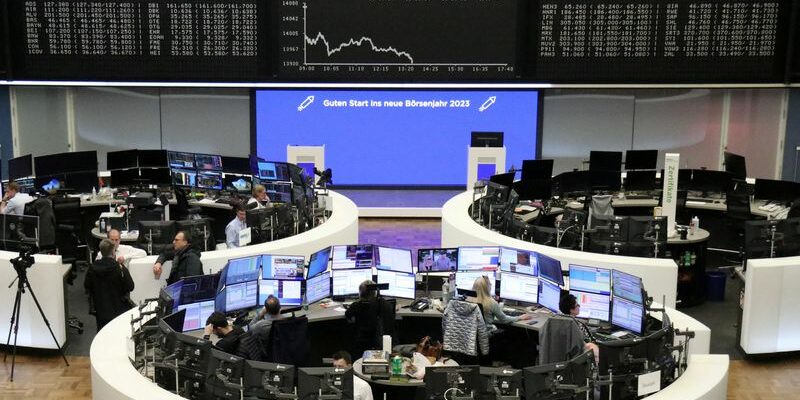(Rehearsal for the closing of the London Stock Exchange)
by Claude Chendjou
PARIS (Reuters) – Wall Street is expected to be in the red at the opening on Friday and risk aversion also dominates trading in Europe at midday for the last session of a stock market year marked by geopolitical tensions, a rise rapid rise in major central bank interest rates and a deterioration in global economic conditions.
Futures on New York indices signal an opening on Wall Street down 0.35% for the Dow Jones, 0.41% for the Standard & Poor’s 500 and 0.53% for the Nasdaq. Over the year as a whole, the three indices are currently heading towards a decline of 8.5%, 19% and 33% respectively.
In Paris, the CAC 40 fell 0.7% on Friday to 6,527.64 around 12:10 GMT. In Frankfurt, the Dax gives up 0.83%. The FTSE dropped 0.81% in London, which closed early at 1:30 p.m. GMT before reopening on Tuesday.
The pan-European FTSEurofirst 300 index lost 0.62%, the EuroStoxx 50 of the euro zone 0.84% and the Stoxx 600 0.61%.
Over the year as a whole, the British Footsie, supported by commodities, should be the only one of the main European stock markets to emerge with a positive balance, of 1.2%. The Parisian CAC 40, for its part, down 8.72% over one year for the moment, should record its largest drop since 2018. The same goes for the Stoxx 600, down at this stage by 12, 12% over one year.
Regarding today’s session, the surge in cases of contamination by the SARS-Cov-2 virus in China after Beijing’s abandonment of the “zero COVID” policy combined with its impact in the country and on global growth continue to shake the financial markets. At the same time, fearing the emergence of new variants, several countries have decided to reestablish border controls, at least for travelers from China.
VALUES IN EUROPE
All the main compartments of the European coast are in the red, one of the most marked declines being for the air transport and leisure sector (-0.83%) which could suffer from new restrictions linked to the health situation in China.
The luxury compartment, also very exposed to China, is suffering with stocks like LVMH (-0.94%), Hermès (-1.91%) and Richemont (-0.29%).
Sectors related to industry (-0.7%), banks (-0.45%) and new technologies (-1.06%) are victims of profit taking after the gains of the previous sessions .
In the news of listed companies, Telecom Italia (TIM) fell by 2.27%, the President of the Italian Council Giorgia Meloni having reaffirmed Thursday that the State had every intention of taking control of the fixed network of the operator. historic Italian telecoms to, she says, preserve jobs.
WALL STREET VALUES TO FOLLOW
CHANGES
At foreign exchange, the dollar fell 0.13% on Friday against a basket of reference currencies. The greenback, up 8.6% year-on-year, should however post its best performance for the year as a whole since 2015 after a period in which the US Federal Reserve (Fed) raised its interest rates by a total of 425 basis points between March and December to curb persistent inflation.
The euro, up 0.09% on Friday to 1.0671 dollars, is heading for an annual loss of 6.2%, due to weak growth in the euro zone, the war in Ukraine and a monetary policy of the European Central Bank (ECB) considered less restrictive than that of the Fed.
The pound sterling, which dropped 0.09% to 1.2041 dollars, could lose 11% against the greenback over the whole of the year.
RATE
On the bond market, the yield of the two-year German Bund, the most sensitive to changes in rates, is up five basis points, at 2.715%, the highest since October 2008, in the perspective of a continued monetary tightening by the ECB after recent statements by Isabel Schnabel and Klaas Knot, two members of the Frankfurt institution.
The ten-year one, which has taken a total of more than 260 basis points this year, is also up about five points, at 2.514%.
In the United States, the yield on ten-year Treasury bills took around two basis points, to 3.853%, and that of two years three points, to 4.394%, while the markets anticipate a peak in Fed rates at nearly 5% in mid-2023 against 4.25-4.5% currently.
OIL
Oil prices are heading for a second consecutive year of gains at the end of a year 2022 of high volatility against a backdrop of geopolitical tensions and concerns about Chinese demand.
Brent, which is posting an annual gain of more than 7% at this stage after an increase of 50% in 2021, fell 0.11% on Friday to 83.55 dollars a barrel.
US light crude (West Texas Intermediate, WTI), up around 4% year-on-year after a 55% gain in 2021, lost 0.01% to $78.39 on Friday.
(Written by Claude Chendjou, edited by Sophie Louet and Matthieu Protard)
